|
[Previous
Page]
CHAPTER II.
HE who first committed himself to the perils of
the great waters must have been peculiarly distinguished among men for his
intrepidity. Modern adventure on the wide ocean, or in comparatively
unknown seas, is not accompanied with that uncertainty and sense of utter
desolation which must have filled the mind of early adventurers when
driven out of sight of land by the tempest; but neither the discovery of
the compass nor the many other aids to safety possessed by modern
navigators free their enterprises from appalling dangers. The
persevering courage of travellers evermore commands our admiration; but
the voyager takes his life in his hand from the moment that he leaves the
shore—the freedom from fear—nay, the cheerfulness and exultation he
experiences when surrounded by the waste of waters, far away from the
enjoyments of house and home; the unsubduable resolution with which he
careers over the wave and encounters every vicissitude of season and
climate; the strength and vastness of the element itself which is the
chief scene of his daring enterprise: these are considerations that ever
interweave themselves with our ideal of the sea-adventurer, and render him
the object of more profound and ardent admiration than the mere traveller
by land.
To ourselves, as natives of a country whose greatness is owing to
commercial enterprise and superiority in the arts of navigation, these
remarks forcibly apply. Maritime discovery has been oftener, much oftener
undertaken by England and Englishmen than by any other country or people
in the world. Many secondary reasons for this might be alleged in addition
to the primary one of discovery. Such undertakings are the means of
training our sailors to hardihood and young officers to the most difficult
and dangerous situations in which a ship can be placed. They accustom the
officers how to take care of, and to preserve the health of a ship's
company. They are the means of solid instruction in the higher branches of
nautical science, and in the use of the various instruments which science
has, of late years especially, brought to such perfection.
The career of the navigator thus assumes a higher character, being that of
a pioneer of science and corroborator of its discoveries, than the employ
or profession of any other man, however elevated the station allotted him
by society. Reflection will convince the young reader that such men as
Cook and Vancouver, Parry and Ross, are much more deserving of triumphal
monuments than martial heroes. The dangers they encountered were fully as
great, while the tendency of their grand enterprises was not to inflict
suffering on mankind but to enlighten it with the knowledge of
distant quarters of the globe, and to bless and enrich it by the
improvement of navigation and commerce. For these reasons, the claim of
the navigator to a high rank in our brief chronicle of the "Triumphs of
Enterprise" would boldly assert itself, independent of the exciting nature
of sea adventures.
Here is an hour of danger described by the heroic Ross, and occurring in
the month of August, 1818, during that intrepid commander's search for the
long wished-for "North-West Passage."
"The two ships were caught by a gale
of wind among the ice, and fell foul of each other. The ice-anchors and
cables broke, one after another, and the sterns of the two ships came so
violently into contact as to crush to pieces a boat that could not be
removed in time. Neither the masters, the mates, nor those men who had
been all their lives in the Greenland service, had ever experienced such
imminent peril; and they declared that a common whaler must have been
crushed to atoms. Our safety must, indeed, be attributed to the perfect
and admirable manner in which the vessels had been strengthened when
fitting for the service. But our troubles were not yet at an end; for, as
the gale increased, the ice began to move with greater velocity, while
the continued thick fall of snow kept from our sight the further danger
that awaited us, till it became imminent. A large field of ice was soon
discovered at a small distance, bearing fast down upon us from the west,
and it thus became necessary to saw docks for
refuge, in which service all hands were immediately employed. It was,
however, found to be too thick for our nine-feet saws, and no progress
could be made. This circumstance proved fortunate, for it was soon after perceived that the field, to which we were moored for this purpose,
was drifting rapidly on a reef of icebergs which lay aground. The topsails
were therefore close-reefed, in order that we might run, as a last
resource, between two bergs, or into any creek that might be found among
them; when suddenly the field acquired a circular motion, so that every
exertion was now necessary for the purpose of warping along the edge that
being the sole chance we had of escaping the danger of being crushed on an
iceberg. In a few minutes we observed that part of the field into
which we had attempted to cut our docks, come in contact with the berg,
with such rapidity and violence as to rise more than fifty feet up its
precipitous side, where it suddenly broke, the elevated part falling
back on the rest with a terrible crash, and overwhelming with its ruins
the very spot we had previously chosen for our safety. Soon afterwards the
ice appeared to us sufficiently open for us to pass the reef of bergs,
and we once more found ourselves in a place of security."
|
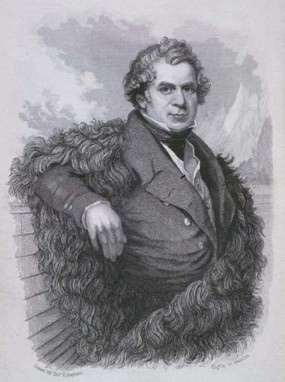 |
|
Sir John Ross (1777–1856)
Rear admiral and Arctic explorer |
The terrors of an iceberg scene are most graphically depicted by Ross, in
the account of his second voyage of discovery. "It is unfortunate," says
he,
"that no description can convey an idea of a scene of this nature;
and, as to pencil, it cannot represent motion
or noise. And to those who have not seen a northern ocean in winter—who
have not seen it, I should say, in a winter's storm—the term ice,
exciting but the recollection of what they only know at rest, in an inland
lake or canal, conveys no ideas of what it is the fate of an arctic
navigator to witness and to feel. But let them remember that ice is stone;
a floating rock in the stream, a promontory or an island when aground, not
less solid than if it were a land of
granite. Then let them imagine, if they can, these mountains of crystal
hurled through a narrow strait by a rapid tide; meeting, as mountains in
motion would meet, with the noise of thunder, breaking from each other's
precipices huge fragments, or rending each other asunder, till, losing
their former equilibrium, they fall over headlong, lifting the sea around
in breakers' and whirling it in eddies; while the flatter fields of ice
forced against these masses, or against the rocks, by the wind and the
stream, rise out of the sea till they fall back on themselves, adding to
the indescribable commotion and noise which attend these occurrences."
How tremendous must be the sense of danger to the tenants of a frail ship
amidst such gigantic forces of nature, the most inexperienced reader can
form some conception. But, overwhelming as the feeling of awe must be
with the sailor surrounded with such terrors, it must be infinitely more
tolerable than the prolonged and indescribably irksome heartache he
experiences when inclosed for months in fixed ice, encompassed on every
hand with desolation. "He must be a seaman," says the same gallant
adventurer,
"to feel that the vessel which bounds beneath
him, which
listens to and obeys the smallest movement of his hand, which seems to
move but under his will, is 'a thing of life,' a mind conforming to his
wishes: not an inert body, the sport of winds and waves. But what seaman
could feel this as we did, when this creature, which used to carry us
buoyantly over the ocean, had been during an entire year immovable as the
ice and the rocks around it, helpless, disobedient, dead? We were weary
for want of occupation, for want of variety, for want of the means of
mental exertion, for want of thought, and (why should I not say it?) for
want of society. To-day was as yesterday—and as was to-day, so would be
to-morrow: while, if there were no variety, no hope of better, is it
wonderful that even the visits of barbarians were welcome? or can anything
more strongly show the nature of our pleasures, than the confession that
these visits were delightful—even as the society of London might be amid
the business of London? When the winter has once in reality set in, our
minds become made up on the subject; like the dormouse (though we may not
sleep, which would be the most desirable condition by far), we wrap
ourselves up in a sort of furry contentment, since better cannot be, and
wait for the times to come: it was a
far other thing to be ever awake, waiting to rise and become active, yet
ever to find that all nature was still asleep, and that we had nothing
more to do than to wish and groan, and—hope as we best might."
|
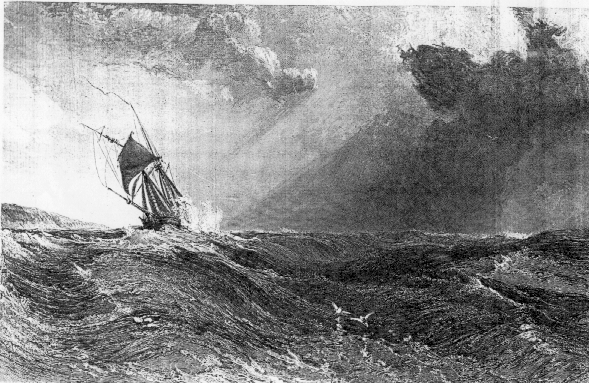 |
|
Sir John Ross's ship with damaged top-mast. |
How truly poetical his description of human feeling
amidst the eternal appearance of ice and snow!—
"When snow was our decks, snow was our
awnings, snow our observations, snow our larders, snow our salt; and, when
all the other uses of snow should be at last of no more avail, our coffins
and our graves were to be graves and coffins of snow. Is this not more
than enough of snow than suffices for admiration? Is it not worse, that
during ten months in a year the ground is snow, and ice, and slush; that
during the whole year its tormenting, chilling, odious presence is ever
before the eye? Who more than I has admired the glaciers of the extreme
north? Who more has loved to contemplate the icebergs sailing from the
Pole before the tide and the gale, floating along the ocean, through calm
and through storm, like castles and towers and mountains, gorgeous in
colouring, and magnificent, if often capricious, in form? And have I, too,
not sought amid the crashing, and the splitting, and the thundering roarings of a sea of moving mountains, for the sublime, and felt that
Nature could do no more? In all this there has been beauty, horror,
danger, everything that could excite; they would have excited a poet even
to the verge of madness.
But to see, to have seen, ice and snow—to have felt snow and ice for
ever, and nothing for ever but snow and ice, during all the months of a
year—to have seen and felt but uninterrupted and unceasing ice and snow
during all the months of four years—this it is that has made the sight of
those most chilling and wearisome objects an evil which is still one in
recollection, as if the remembrance would never cease."
To bid farewell to his ship in these regions of deathly solitariness must
be a trial of the heart even severer than its sense of awe amid icebergs,
or wearisomeness with the eternal snow. This fell to the lot of the brave
Ross and his crew. Fast beset where there was no prospect of release, they
commenced carrying forwards a certain quantity of provisions, and the
boats with their sledges, for the purpose of advancing more easily
afterwards. The labour of proceeding over ice and snow was most severe,
and the wind and snow-drift rendered it almost intolerable. On the 21st of
May, 1832 (for this was during Sir John Ross's second voyage) all the
provisions from their ship, the Victory, had been carried forward to the
several deposits, except as much as would serve for about a month. In the
process of forming these deposits it was found that they had travelled,
forwards and backwards, three hundred and twenty-nine miles to gain about
thirty in a direct line. Preparation was now made for their final
departure, which took place on the 29th. of May.
"We had now," continues the commander,
"secured everything on shore which could
be of use to us in case of our return; or which, if we could not, would
prove of use to the natives. The colours were therefore hoisted and
nailed to the mast, we drank a parting glass to our poor ship, and having
seen every man out, in the evening I took my own adieu of the Victory,
which had deserved a better fate. It was the first vessel that I had
ever been obliged to abandon, after having served in thirty-six, during a
period of forty two years. It was like the last parting with an old
friend; and I did not pass the point where she ceased to be visible
without stopping to take a sketch of this melancholy desert—rendered more
melancholy by the solitary, abandoned, helpless home of our past years,
fixed in immovable ice till Time should perform on her his usual work."
After a full month's most fatiguing journey, they encamped
and constructed a canvas-covered house. This they deserted, and set
out once more, but, after several weeks' vain attempt to reach navigable
water, were compelled to return, "their labours at an end, and themselves
once more at home," Here—of the provisions left behind them—flour,
sugar, soups, peas, vegetables, pickles, and lemon-juice, were in
abundance; but of preserved meats there remained not more than would
suffice for their voyage in the boats during the next season. A
monotonous winter was spent in their house; and the want of exercise, of
sufficient employment, short allowance of food, lowness of spirits
produced by the unbroken sight of the dull, melancholy, uniform waste of
snow and ice, had the effect of reducing the whole party to a more
indifferent state of health than had hitherto been experienced.
"We were indeed all very weary of this miserable home," says
Sir John Ross.
"Even the storms were without variety:
there was nothing to see out of doors, even when we could face the sky;
and within it was to look equally for variety and employment, and to find
neither. If those of the least active minds dozed away their time in
the waking stupefaction which such a state of things produces, they were
the most fortunate of the party. Those among us who had the enviable
talent of sleeping at all times, whether they were anxious or not, fared
best."
At length the long-looked-for period arrived when it was
deemed necessary to abandon the house in search of better fortune; and on
the 7th of July, being Sunday, the last divine service was performed in
their winter habitation. The following day they bid adieu to it for
ever! and having been detained a short time at Batty Bay, and finding the
ice to separate and a lane of water to open out, they succeeded in
crossing over to the eastern side of Prince Regent Inlet. Standing
along the southern shore of Barrow's Strait, on the 26th of August they
discovered a sail, and, after some tantalizing delays, they succeeded in
making themselves visible to the crew of one of her boats.
"She was soon alongside," proceeds Sir John Ross,
"when the mate in command addressed us,
by presuming that we had met with some misfortune and lost our ship.
This being answered in the affirmative, I requested to know the name of
his vessel, and expressed our wish to be taken on board. I was
answered that it was the 'Isabella of Hull, once commanded by Captain
Ross;' on which I stated that I was the identical man in question, and my
people the crew of the Victory. That the mate who commanded this
boat was as much astonished at this information as he appeared to be I do
not doubt; while, with the usual blunder-headedness of men on such
occasions, he assured me that I had been dead two years! I easily
convinced him, however, that what ought to have been true, according to
his estimate, was a somewhat premature conclusion, as the bear-like form
of the whole set of us might have shown him had he taken time to consider
that we were certainly not whaling gentlemen, and that we carried
tolerable evidence of our being 'true men, and no impostors' on our backs,
and in our starved and unshaven countenances. A hearty
congratulation followed, of course, in the true seaman style, and after a
few natural inquiries he added that the 'Isabella was commanded by Captain
Humphreys,' when he immediately went off in his boat to communicate his
information on board, repeating that we had long been given up as lost,
not by them alone, but by all England.
"As we approached slowly after him to the ship, he jumped up
the side, and in a minute the rigging was manned, while we were saluted
with three cheers as we came within cable's length, and were not long in
getting on board of my old vessel, where we were all received by Captain
Humphreys with a hearty seaman's welcome.
"Though we had not been supported by our names and
characters, we should not the less have claimed, from charity, the
attentions that we received, for never was seen a more miserable-looking
set of wretches; while, that we were but a repulsive-looking people, none
of us could doubt. If to be poor, wretchedly poor, as far as all our
present property was concerned, was to have a claim on charity, no one
could well deserve it more; but if to look so as to frighten away the
so-called charitable, no beggar that wanders in Ireland could have outdone
us in exciting the repugnance of those who have not known what poverty can
be. Unshaven since I know not when, dirty, dressed in the rags of
wild beasts instead of the tatters of civilization, and starved to the
very bones, our gaunt and grim looks, when contrasted with those of the
well-dressed and well-fed men around us, made us all feel, I believe for
the first time, what we really were as well as what we seemed to others.
Poverty is without half its mark unless it be contrasted with wealth; and
what we might have known to be true in the past days, we had forgotten to
think of till we were thus reminded of what we truly were as well as
seemed to be.
"But the ludicrous soon took place of all other feelings; in
such a crowd and such confusion all serious thought was impossible, while
the new buoyancy of our spirits made us abundantly willing to be amused by
the scene which now opened. Every man was hungry and was to be fed,
all were ragged and were to be clothed, there was not one to whom washing
was not indispensable, nor one whom his beard did not deprive of all
English semblance. All, everything, too, was to be done at once; it
was washing, dressing, shaving, eating, all intermingled; it was all the
materials of each jumbled together; while, in the midst of all, there were
interminable questions to be asked and answered on all sides: the
adventures of the Victory, our own escapes, the politics of England, and
the news which was now four years old. But all subsided into peace
at last. The sick were accommodated, the seamen disposed of, and all
was done for all of us which care and kindness could perform. Night
at length brought quiet and serious thoughts, and I trust there was not
one man among us who did not then express, where it was due, his gratitude
for that interposition which had raised us all from a despair which none
could now forget, and had brought us from the very borders of a not
distant grave to life, and friends, and civilization.
"Long accustomed, however, to a cold bed on the hard snow or
the bare rock, few could sleep amid the comfort of our new accommodations.
I was myself compelled to leave the bed which had been kindly assigned me,
and take my abode in a chair for the night, nor did it fare much better
with the rest. It was for time to reconcile us to this sudden and
violent change, to break through what had become habit, and to inure us
once more to the usages of our former days."
As a curious contrast to these exciting descriptions of
danger, we will sketch in as compact a form as possible the first voyage
round the world performed by an Englishman—namely, our illustrious
countryman, Sir Francis Drake.
|
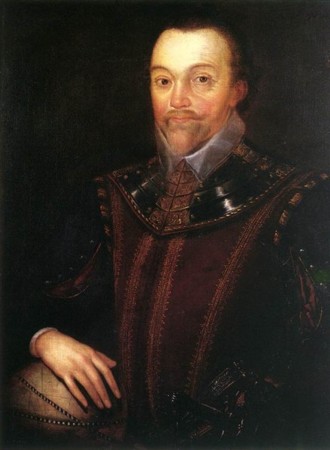 |
|
Sir Francis Drake (ca. 1540–1596)
Vice-Admiral, privateer, navigator and slave trader |
Queen Elizabeth, on presenting a sword to the commander of a
secret expedition, said, "We do account that he which striketh at thee,
Drake, striketh at us." His fleet consisted of five ships—the
Pelican, of 120 tons burthen; the Elizabeth, a barque of 80 tons; the
Swan, a fly-boat of 50 tons; the Marygold, a barque of 30 tons, and the
Christopher, a pinnace of 15 tons, and was ostensibly fitted out for a
trading voyage to Alexandria, though this pretence did not deceive the
watchful Spaniards. Drake, like Columbus and Cook, chose small ships
as better fitted to thread narrow and difficult channels. The crews
of his little squadron amounted to one hundred and sixty men; an old
author says that he did not omit "provision for ornament and delight,
carrying with him expert musicians, rich furniture (all the vessels for
his table, yea, many belonging to his cook-room, being of pure silver),
with divers shows of all sorts of curious workmanship whereby the civility
and magnificence of his native country might, among all nations whither he
should come, be the more admired"
|
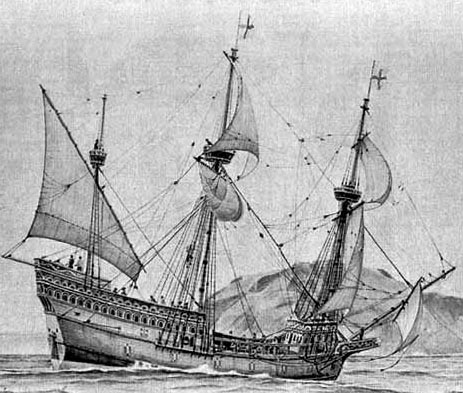 |
|
Drake's ship the Pelican, renamed Golden Hind |
Although it is likely that the intrepid resolve of crossing
the Pacific Ocean was not originally formed by Drake, and only entered
into from circumstances in which he was afterwards placed, he is not the
less entitled to the praise so often given him for penetrating with so
small a force the channel explored by Magellan and known by his name.
The passage through the Straits of Magellan had long been abandoned by the
Spaniards, and a superstition had arisen against adventuring into the
Pacific, as likely to prove fatal to any who are engaged in the discovery
or even in the navigation of its waters.
Drake was at first driven back by a violent storm; but,
unintimidated by this adverse augury, he finally set sail from Plymouth on
the 13th of December, 1577. On Christmas-day they reached Cape
Cantin, on the coast of Barbary, and on the 27th found a safe and
commodious harbour in Mogadore. Here Drake had some unpleasant
transactions with Muley Moloc, the celebrated king of the Moors, but
sailed again on the last day of the year. The less important places
touched at in the succeeding part of the voyage were Cape Blanco, the
isles of Mayo and San Jago, and the "Isla del Fogo," or Burning Island,
together with "Ilba Brava," or the Brave Island. The equinoctial
line is afterwards crossed amidst alternate calms and tempest; they are
supplied with fresh water by copious rains, and they also catch dolphins,
bonitos, and flying-fish which fell on the decks, "where hence," says the
invaluable Hakluyt, "they could not rise againe for want of moisture, for
when their wings are drie they cannot flie." At length, on the 5th
of April, they had fully voyaged across the wide Atlantic, and made the
coast of Brazil in 3l° 30' south latitude. They saw the natives
raising fires on the shore, beheld troops of wild deer, "large and mightie,"
and saw the footprints of men of large stature on the beach. On the
15th of the same month they anchored in the great River Plate, where they
killed "certaine sea-wolves, commonly called seales." They thus
secured a new supply of fresh provisions, and shortly after of fresh
water.
On the 27th they again stood out to sea, and steered
southward. The Swan was outsailed by the rest of the little fleet,
and also the Mary, a very small Portuguese vessel, or caunter, which they
had taken in their course. On the 12th of May, Drake anchored within
view of a headland, and the next morning went in a boat to the shore.
Here he was in some danger, for a thick fog came on and shut him from the
view of the vessels; a gale also arose and drove them out to sea.
Fires were at length lighted, all the vessels, save the Swan and the Mary,
were again collected together. Fifty dried ostriches, besides other
fowls, are related to have been here found deposited by the savages, and
of this store the ships' crews took possession. Upwards of two
hundred seals were also taken and slaughtered; and while a party was
filling water-casks, killing seals, and salting fowl, for future
provision, Drake himself set sail in the Pelican, and Captain Winter in
the Elizabeth, each on different tacks, in search of the Swan and the
Mary. Drake soon found the Swan, and, to diminish the cares and
hazards of the voyage, removed all her stores and then broke her up for
firewood.
The place of rendezvous was named Seal Bay, and some highly
interesting accounts of interviews with the savage native tribes during
their stay here are given in Hakluyt. On the 3rd of June they set
sail once more; on the 19th they found the missing Portuguese prize, the
Mary; and the next day the whole squadron moored in Port San Julian,
latitude 49° 30' S.
A very perilous squabble took place here with the native
Patagonians. A gunner belonging to the crew was shot through with an
arrow, and died on the spot, and Robert Winter, relative of the officer
above mentioned, was wounded, and died in consequence shortly afterwards.
The stature of these tribes has been the subject of dispute from the time
of Magellan to our own. An old author in Hakluyt says, "These men be
of no such stature as the Spaniardes report, being but of the height of
Englishmen: for I have seene men in England taller than I could see any of
them. But peradventure the Spaniard did not thinke that any
Englishman would have come thither so soone to have disproved them in this
and divers others of their notorious lies." Another author, however,
makes the Patagonians seven feet and a half in height.
An event occurred while the fleet lay at Port San Julian,
which has cast a deep shade of suspicion over the character of Drake.
This was the execution of Thomas Doughty, accused of mutiny and a
conspiracy to massacre Drake and the principal officers. We leave
the young reader to investigate the matter in other works, and proceed
with our abridged narrative.
After breaking up the Portuguese prize and reducing the number of ships to
three, they again set sail on the 17th of August—the weather being colder
than midwinter in Britain—and on the 24th anchored thirty leagues within
the Strait of Magellan. Here Drake changed the name of his ship, the
Pelican, to the Golden Hind, in compliment to his friend, Sir Christopher
Hatton, in whose escutcheon the golden hind is said to have had a place.
While passing through the strait, which they computed to be 110 leagues in
length, they noted that the width varied from one league to four; that the
tide set in from each end of the strait and met about the middle; and they
also killed 3000 "of birds having no wings, but short pineons which serve
their turne in swimming." These penguins, as they undoubtedly were,
are also described as being "fat as an English goose."
On the 6th of September, 1578, Drake and his gallant crew
sailed their ships on the great Pacific. Magellan had passed through
the strait in 1520, and but two other voyagers had performed the passage
after Magellan, and before Drake.
A north-east passage was one main object contemplated by
Drake; and accordingly, on clearing the strait, he held a north-west
course, and in two days the fleet advanced seventy leagues. A
violent gale from the north-east now drove them into 57 south latitude and
200 leagues to the west. Under bare poles they scudded before the
tempest, and observed an eclipse of the moon on the 15th of September;
"but," says a narrator, in Hahluyt, "neyther did the eclipticall conflict
of the moon impayre our state, nor her clearing againe amend us a whit,
but the accustomed eclipse of the sea continued in his force, wee being
darkened more than the moone sevenfold." After a short season of
moderate weather, another tempest separated from them the ship Marygold,
and she was never more heard of. The Golden Hind and Elizabeth were
now left to pursue the voyage; but on being driven back to the western
entrance of the strait, Winter, the commander of the Elizabeth, heartily
tired of the voyage, slipped away from Drake and returned to England.
He reached this country in June, 1579, with the credit of having achieved
the navigation of the Straits of Magellan, but with the shame of having
deserted his commander.
The gallant Drake in the Golden Hind had stormy weather to
encounter for some time after, and was driven so far south as to anchor in
a creek at Cape Horn, and thus became the discoverer of that southern
point of the entire continent of America.
The wind changing he steered northwards, and on the 25th of
November, 1578, anchored near the coast of Chili, where he had another
collision with the natives and lost two of his men. Soon afterwards
they fell in with a people of more friendly manners, and learned that they
had over-sailed Valparaiso, the port of San Jago, where a Spanish ship lay
at anchor. They put back and took the ship, called the Grand Captain
of the South, in which were 60,000 pesos of gold, besides jewels,
merchandise, and a good store of Chili wine. Each peso was valued at
eight shillings. They rejoiced over their plunder; but in our own
times such an act would be deemed a piracy. Nine families inhabited
Valparaiso, but they fled, and the English revelled in the pillage of
wine, bread, bacon, and other luxuries to men long accustomed to hard
fare. They plundered the church also of a silver chalice, two
cruets, and an altar-cloth, and presented them to the chaplain of the
vessel.
On the 19th of January, 1579, after some period of rest in a
harbour, they pursued their voyage along the coast, and accidentally
landing at Tarapaza, they found a Spaniard asleep on the shore with
thirteen bars of silver lying beside him. "We took the silver and
left the man," says the relator. A little farther on, a party which
was sent ashore to procure water fell in with a Spaniard and a native boy
driving eight llamas, each of which was laden with two leathern bags
containing fifty pounds of silver, or eight hundred in all. They not
only took on board the llamas and the silver, but soon after fell in with
three small barks quite empty (the crews being on shore), save that they
found in them fifty-seven wedges of silver, each weighing twenty pounds.
They took the silver and set the barks adrift. After some other
trifling adventures they learned that the Cacafuego, a ship laden with
gold and silver, had just sailed for Panama, the point whence all goods
were carried by the Spaniards across the isthmus. Away they bore in
search of this ship, but were near being overtaken by a superior force of
Spaniards in two ships. Escaping, they passed Payta, and learned
that the Cacafuego had the start of them but two days. Two other
vessels were next taken, with some silver, eighty pounds of gold, and a
golden crucifix "with goodly great emerauds set in it." The
Cacafuego was at length overtaken and captured: the ship contained
twenty-six tons of silver, thirteen chests of rials of plate, and eighty
pounds of gold, besides diamonds and inferior gems, the whole estimated at
360,000 pesos. The uncoined silver alone found in the vessel may be
estimated at £212,000, at five shillings an ounce.
It seems questionable whether, when thus richly laden, Drake
would have thought of encompassing the globe if he could have assured
himself of a safe voyage to England by returning through the Straits of
Magellan. He knew that the Spaniards would be on the alert to
recover the treasure, and so resolved to seek a north-east passage
homeward. After remaining a short time in a safe harbour to repair
the ship, he commenced the voyage once more. Delays were made for
plunder and prize-taking until the 26th of April, when Drake stood boldly
out to sea, and by the 3rd of June had sailed 1400 leagues on different
courses without seeing land. He had now reached 42° north latitude,,
and the cold was felt severely. On the 5th, being driven by a gale,
land was seen, to the surprise of Drake, who had not calculated that the
continent stretched so far westward. The adventurers were now
coasting the western margin of California.
They anchored at length in 38° 30' north latitude, and were
soon surrounded with native Indians, who, among other remarkable things,
offered them tabah, or tobacco. Drake spent thirty-six days
here for completing the repairs of his ship, took possession of the
country formally, by erecting a monument and fixing a brass plate upon it,
bearing the name, effigy, and arms of Queen Elizabeth, and called the
country New Albion. To the port in which they had anchored he gave
his own name, and on the 23rd of July bore away direct west as possible
across the Pacific, with the intent to reach England by India and the Cape
of Good Hope.
No land was seen by the gallant men on board this little ship
for sixty-eight days. On the 30th of September they fell in with
some islands in 8° north latitude, which they termed the Isle of Thieves,
from the dishonest disposition of the natives. On the 16th of
October they reached the Philippines, and anchored at Mindanao. On
the 3rd of November the Moluccas were seen, and they soon anchored before
the chief town of Ternate, entered into civil gossip with the natives, and
were visited by the king, "a true gentleman Pagan." Among the
presents received from this royal person were fowls, rice, sugar, cloves,
figs, and "a sort of meale which they call sagu, made of the tops
of certaine trees, tasting in the mouth like soure curds, but melteth like
sugar, whereof they make certaine cakes, which may be kept the space of
ten yeeres and yet then good to be eaten." Brilliant offers were
made by the Sultan of Ternate; but Drake was shy of them, and on the 9th
of November, having taken in a large quantity of cloves, the Golden Hind
left the Moluccas.
On the 14th they anchored near the eastern part of Celebes,
and finding the land uninhabited and abundant in forests, they determined
there fully to repair the ship for her voyage home. "Throughout the
groves," say the old writers in Purchas and Hakluyt, "there flickered
innumerable bats 'as bigge as large hennes.' There were also
multitudes of 'fiery wormes flying in the ayre,' no larger than the common
fly in England, which skimming up and down between woods and bushes, made
'such a shew and light as if every twigge or tree had bene a burning
candle.' They likewise saw great numbers of land-crabs, or cray-fish,
'of exceeding bignesse, one whereof was sufficient for foure hungry
stomackes at a dinner, being also very good and restoring meat, whereof
wee had experience; and they digge themselves holes in the earth like
conies.'"
On the 12th of December they again set sail; but now came
their great peril. After being entangled in shoals among the Spice
Islands for some days, in the night of the 9th of January, 1580, the
Golden Hind struck on a rock. No leak appeared; but the ship was
immovable. The ebb tide left her in but six feet water, while, so
deeply was she laden, that it required thirteen feet of water to float
her. Eight guns, three tons of cloves, and a quantity of meal were
thrown overboard, but this did not relieve the ship. "We stucke
fast," says the narrator in Hakluyt, "from eight of the clocke at night
til foure of the clocke in the afternoone the next day, being indeede out
of all hope to escape the danger; but our generall, as he had alwayes
hitherto shewed himself couragious, and of a good confidence in the mercie
and protection of God, so now he continued in the same; and lest he should
seeme to perish wilfully, both hee and wee did our best indevour to save
ourselves, which it pleased God so to blesse, that in the ende we cleared
ourselves most happily of the danger."
Their ship in deep water once more, they reached the Isle of
Barateve on the 8th of February, and were kindly and handsomely treated by
the inhabitants. Java was reached on the 12th of March, and here
again they were generously received, on the 26th they left Java, and did
not again see land till they passed the Cape of Good Hope, on the 15th of
June. The Portuguese being acquaintances, Drake did not wish just
then to meet; he did not land at the Cape, but steered away north, and on
the 22nd of July arrived at Sierra Leone. Finally, on the 26th of
September, 1580, after an absence of two years and ten months, he came to
anchor in the harbour of Plymouth.
The riches he had brought home, the daring bravery he had
displayed, the perils undergone, the marvels told of the strange countries
visited, made Drake the idol of the whole English people. On the 4th
of April, 1581, Queen Elizabeth went in state to dine on board the Golden
Hind, then lying at Deptford. After the banquet she knighted the
gallant circumnavigator, and also gave orders that his vessel should be
preserved as a monument of the glory of the nation and of the illustrious
voyager.
CHAPTER III.
WORTHY of companionship with these records of the
triumphs of enterprise in Africa, are the records of expeditions
undertaken, great hardships bravely endured, and great successes achieved
in the work of Australian exploration.
The settled portions of the great Australian colonies, with their splendid
cities, numerous busy towns, rich deposits of gold, and immense pasture
lands, are chiefly on the eastern and southern coasts of the island
continent. West Australia, on the opposite side, is less commercially
important. The towns are comparatively small, and the population more of a
poetical character than the energetic traders, miners, and speculators of
the other colonies.
On the southern side of Australia are the colonies of South Australia and
Victoria; on the eastern, New South Wales, and, farther north, Queensland. Nearly half the island, the interior and north-eastern part, so fringed by
settlements was, until a few years since, an unknown land; and it is only
by the existence of a spirit of adventure and perseverance, equal to that
shown in African
exploration, that any knowledge of the character of the country has been
obtained. A notice of some of the more remarkable expeditions undertaken,
will form an interesting chapter in the history of the triumphs of
perseverance.
|
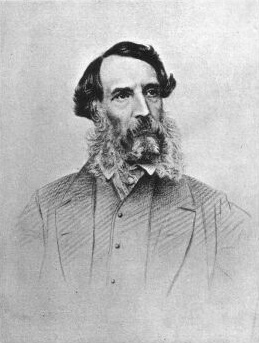 |
|
Edward John Eyre (1815—1901)
English explorer of the Australian continent |
Several minor journeys of exploration had been undertaken chiefly in the
eastern part of the Continent, when in 1840, Mr. Eyre, an adventurous
colonist, resolved to attempt an overland journey along the southern
coast, and ascertain the nature of the country lying between Spencer Gulf,
now the very centre of South Australia, and the settlements on Swan River,
near West Australia. He performed the distance of upwards of a thousand
miles entirely on foot, accompanied for the greater part of the distance
by only one native boy, two other natives having robbed and deserted him
early on the journey. Hunger and thirst were endured, and the hardships of
the brave explorer were almost incredible. The district he traversed was a
vast desert, no streams flowing into the great ocean bay, known as the
Bight of Australia. At length he reached the sea, and fainting and
exhausted looked on the great waste of waters, as he thought for the last
time, for he felt that death was near. His native boy saw a speck on the
waves. It came nearer and nearer, and was seen to be a boat which had just
rounded a point. Signals were made and seen, and soon the worn-out
travellers were on
board a small French vessel, where they rested and were restored to
strength. Then they landed, and with a renewed vigour completed the long
journey.
|
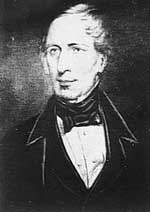 |
|
Charles Napier Sturt
(1795–1869), English
explorer of Australia |
In 1845, Mr. Sturt undertook a journey northward from South Australia. It
was generally suppossed that in the interior of the continent was a great
inland sea; but Sturt, after a journey of nearly a thousand miles, found
only a vast desert, without rivers, the sandy tracks interspersed with
patches of coarse herbage. The heat was intense, and the winds scorching. The only water found was that which had accumulated in rock-holes in the
rainy season.
The northernmost of Australia, as is well known, stretches into the
tropical region, almost joining the great islands of the Indian
archipelago. A small station for the protection of shipwrecked mariners
had been formed by the British Government on the north coast, and it was
as desirable to know if a practicable route between this point and Moreton
Bay, on the west coast (now included in the colony of Queensland) could be
established.
|
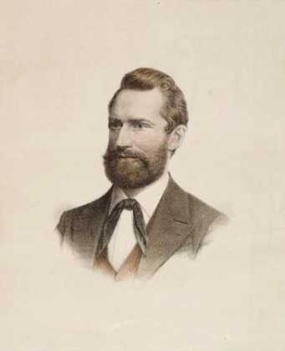 |
|
Friedrich Wilhelm Ludwig Leichhardt
(1813—1848?), Prussian explorer of
Australia |
In 1847, Dr. Leichardt, who had had some experience as an explorer,
started on an expedition, and achieved a journey around the northern
shores of the continent, travelling about three thousand miles in fifteen
months. Two years afterwards he conceived the idea of crossing Australia
from east to west. A communication was received from him about nine
months afterwards, describing considerable hardships endured;
and from that time no further trace of him could be obtained. Various
attempts have been made to ascertain his fate; but except that here and
there along the route he is supposed to have taken, his initials were
found cut on the bark of trees, no information could be obtained. No
doubt, he died miserably of starvation, unless, indeed, he was murdered by
natives, who, fearing retaliation, would conceal every trace of their
crime from subsequent explorers.
In 1860, Mr. M'Douall Stuart, a companion of Sturt in his journey,
endeavoured to cross from south to north, and reached a point in the
centre of the continent which was named Mount Stuart; but the violent
opposition of the natives prevented a further advance. Two years
afterwards he made another attempt, and succeeded in reaching the Indian
Ocean. Another expedition had been a short time previously undertaken from
the colony of Victoria, under the command of Mr. Burke, accompanied by a
large party, with camels and a good store of necessaries. Finding the
party too large, he left the greater number behind at an early stage of
his journey, and accompanied by his second in command, Mr. Wills, and two
others, succeeded in reaching the northern coast, being the first
explorers who had passed from sea to sea. On their return journey, they
suffered terribly—Burke and
Wills dying from exhaustion, and the only surviving member of the party,
King, was rescued by a relief expedition, under Mr Howitt, which had been
sent to seek the long-missing explorers.
|
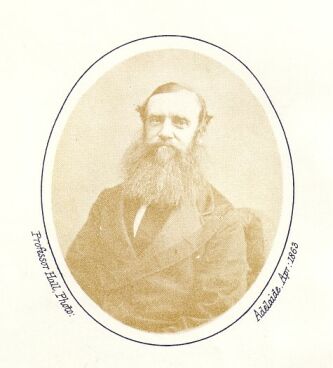 |
|
John McDouall Stuart (1815–1866)
The most accomplished of
Australia's inland explorers |
Since then, a telegraph line has been stretched across the continent,
connecting the Anglo-Indian lines with the southern colonies; and many
other expeditions have been made, notably by Colonel Warburton, who
crossed from east to west, enduring terrible hardships before he reached
the western settlements, and by Mr. John Forrest, who not only traversed
successfully, in a contrary direction, the route taken by Mr. Eyre, and so
established a road between West and South Australia, but crossed from West
Australia to the telegraph line, and so reached South Australia, each
expedition being conducted without loss of life. Forrest, and men of his
stamp, are noble examples of what may be achieved by resolute courage, and
a persevering defiance of what to more timid hearts might appear to be
insurmountable difficulties.
|
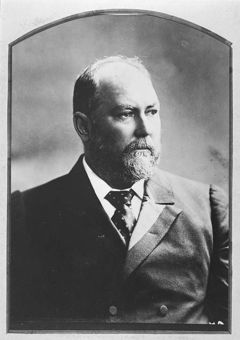 |
|
Sir John Forrest (1847–1918)
Australian explorer |
There are many other names which deserve to be mentioned honourably in
connexion with Australian exploration. Sir J. Mitchell explored Eastern
Australia between 1831 and 1836; and between 1845 and 1848, accompanied
Mr. Kennedy and Mr. A. C. Gregory on several expeditions, in the course of
which the courses of the Barcoo river and its tributaries were traced. Mr. Landsborough crossed from north to south, and Mr. McKinlay from south to
north, in 1862. In 1873, Mr. Gosse attempted to reach West Australia from
the telegraph line, but was unsuccessful.
In Western and Northern Australia, the brothers Gregory have made several
journeys of exploration, and to them we are indebted for a knowledge of
large tracts of country suitable for colonization, and of important rivers
discharging on the north-western coast. That the country in that part of
the great island continent is fitted for the establishment of settlements
cannot be doubted; and before many years are past, there may be great
towns on sites which were grassy spots when trodden by the feet of the
enterprising explorers.
We may remember with admiration that Sydney, the oldest town in Australia,
and now one of the finest in the world, is only about ninety years old,
and that forty years ago the sites of Melbourne, Adelaide, and other
towns, now with immense populations and noble public buildings, were
almost unknown spots in untrodden wildernesses. Their foundation and rapid
progress are grand memorials of what enterprise can achieve.
CHAPTER IV.
ONE path of Enterprise belongs distinctly to modern
adventurers—the search after interesting remains of antiquity, and
investigation of their present actual condition. Such enterprises of
discovery have often their source in a love of Art, which can only exist
in the most cultivated minds. In other instances they arise from a
laudable desire to verify ancient history, and thus serve the highly
important purpose of confirming that branch of human knowledge which has
hitherto depended simply on the testimony of written tradition.
|
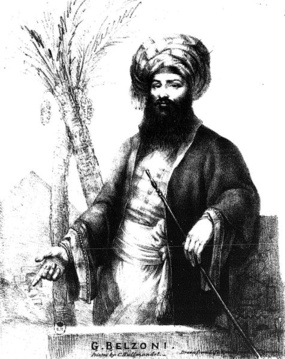 |
|
Giovanni Battista Belzoni (1778–1823)
Italian explorer of Egyptian antiquities. |
Perhaps the greatest contributor to certain knowledge in this department
of enterprise and discovery was the celebrated Belzoni, though our
acquaintance with the time-honoured and mysterious monuments of Egypt has
been enlarged by many other travellers. Greece has also had her
distinguished list of antiquarian explorers; and the glowing lands of the
East, so famous in sacred and profane story, have been visited by numerous
travellers, each and all ardent to survey and report the present condition
of the diversified monuments of human skill and strength existing in the
primeval countries of our race.
Every youthful visitor to the British Museum will be
interested with the beautiful black granite statue so well known as "the
young Memnon." Near the left foot of this gigantic sitting figure
will be found the name of Belzoni, cut by his own hand. Burckhardt
and Salt were the enterprising and disinterested persons who paid the
expenses of conveying this massive piece of ancient sculpture to
Alexandria: Belzoni and his assistants undertook the immense labour.
|
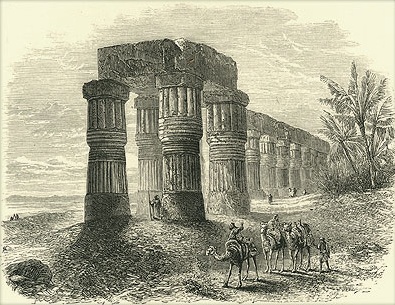 |
|
Temple at Luxor |
It was amidst the ruins of Thebes, old Homer's "city of the
hundred gates," that this far-famed statue of an old Egyptian king had
long lain. His wonder at entering this ruined metropolis is thus described
by Belzoni:
"We saw for the first time the ruins of
great Thebes, and landed at Luxor. Here I beg the reader to observe
that but very imperfect ideas can be formed of the extensive ruins of
Thebes, even from the accounts of the most skilful and accurate
travellers. It is absolutely impossible to imagine the scene
displayed without seeing it. The most sublime ideas that can be
formed from the most magnificent specimens of our present architecture
would give a very incorrect picture of these ruins; for such is the
difference, not only in magnitude, but in form, proportion, and
construction, that even the pencil can convey but a faint idea of the
whole. It appeared to me like entering a city of giants, who, after
a long conflict, were all destroyed, leaving the ruins of their various
temples as the only proof of their former existence. The temple of
Luxor presents to the traveller at once one of the most splendid groups of
Egyptian grandeur. The extensive propylæon,
with the two obelisks, and colossal statues in the front; the thick groups
of enormous columns; the variety of apartments and the sanctuary it
contains; the beautiful ornaments which adorn every part of the walls and
columns, cause in the astonished traveller an oblivion of all that he has
seen before. If his attention be attracted to the north side of
Thebes by the towering remains that project a great height above the wood
of palm trees, he will gradually enter that forest-like assemblage of
ruins of temples, columns, obelisks, colossi, sphynxes, portals, and an
endless number of other astonishing objects, that will convince him at
once of the impossibility of a description. On the west side of the
Nile, still the traveller finds himself among wonders. The temples
of Gournou; Memnonium, and Medinet Aboo, attest the extent of the great
city on this side. The unrivalled colossal figures in the plain of
Thebes, the number of tombs excavated in the rocks, those in the great
valley of the kings, with their paintings, sculptures, mummies;
sarcophagi, figures, &c., are all objects worthy of the admiration of the
traveller, who will not fail to wonder how a nation which was once so
great as to erect these stupendous edifices could so far fall into
oblivion, that even their language and writing are totally unknown to us."
|
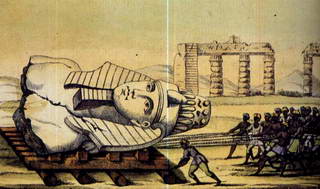 |
|
Moving the bust of "Memnon" (Ramesses II),
in Belzoni, "Travel to Egypt and Nubie" |
The bust of Memnon, the immediate object of Belzoni's
research, soon caught his eye. It was lying with its face upwards,
and "apparently smiling on me," says Belzoni, "at the thought of being
taken to England." Among a semi-barbarous people like the Arabs the
discoverer had a thousand difficulties to overcome before he could succeed
in moving this bust of ten or twelve tons weight one inch from its bed of
sand. The chiefs eyed him with jealousy, and conceived, as usual,
that he came in quest of hidden treasures; and the Fellahs were with
difficulty set to work, having made up their minds that it was a hopeless
task. When these simple people saw it first move they all set up a
loud shout, declaring that it was not their exertions but the power of the
devil that had effected it. The enormous mass was put in motion by a
few poles and palm-leaf ropes, all the means which they could command, and
which nothing but the ingenuity of Belzoni could have made efficient.
But these materials, poor as they were, created not half the difficulty
and delay occasioned by the intrigues of the Cachefs and Kaimakans, all of
whom were desirous of extorting as much money as they possibly could, and
of obstructing the progress of the work, as the surest means of effecting
their purpose. Even the labourers, on finding that money was given
to them for removing a mere mass of stone, took it into their heads that
it must be filled with gold, and agreed that so precious an article ought
not to be taken out of the country. Belzoni succeeded, however, in
allaying these ridiculous imaginings, and eighteen days after the
commencement of the operation, the colossal bust reached the banks of the
Nile. One day was consumed in embarking it; and after a voyage of
hazard among the cataracts of the Nile, the illustrious traveller reached
Cairo with his prize. From thence he conveyed it to Alexandria, and
lodged it in the Pasha's magazine; he then returned to Cairo, and
accompanied by Mr. Beechy, immediately proceeded up the Nile, with the
determination, if possible, to accomplish the opening of the great temple
of Ipsambul, a labour he had commenced but a short time before.
This grand and gigantic relic of antiquity was discovered and
brought into notice by the lamented Burckhardt, but when Belzoni first
approached it, the accumulation of sand was such "that it appeared an
impossibility ever to reach the door." The exact spot where he had
fixed the entrance to be was determined in his own mind from observing the
head of a hawk, of such a monstrous size that, with the body, it could not
be less than twenty feet high. This bird he concluded to be over the
doorway; and as below the figure there is generally a vacant space,
followed by a frieze and cornice, he calculated the upper part of the
doorway to be about thirty-five feet below the summit of the sand.
|
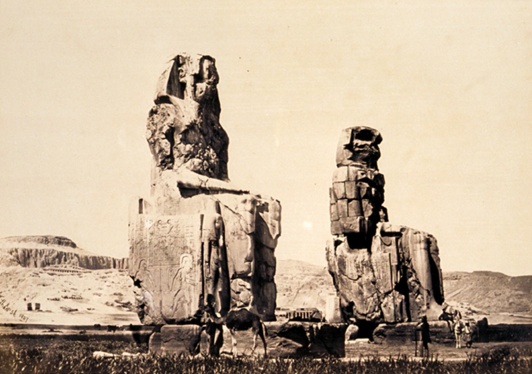 |
|
"The Statues of
Memnon"
Photographed by Francis
Frith, 1857 |
Having succeeded in procuring for hire, from one of the
cachefs, as many labourers as he could afford to employ, Belzoni set about
clearing away the sand from the front of the temple. The only
condition made with the cachef was, that all the gold and jewels found in
it should belong to him, as chief of the country, and that Belzoni should
have all the stones. At the end of four or five days his funds were
entirely exhausted; be therefore, after obtaining a promise from the chief
that no one should molest the work in his absence, resumed his search for
other antiquities; and, after conveying the Memnon to Alexandria, and
being joined by Mr. Beechy at Cairo, met, at Philæ,
with Captains Irby and Mangles of the British Navy, and was joined also by
them.
|
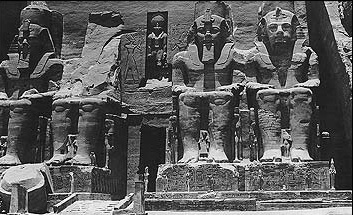 |
|
The great temple of Ipsambul |
Having conciliated the cachefs by suitable presents, they agreed to give
the workmen, who were eighty in number, three hundred piastres for
removing the sand as low down as the entrance. At first they seemed to set
about the task like men who were determined to finish the job; but, at the
end of the third day, they all grew tired, and, "under the pretext that
the Rhamadan was to commence on the next day, they left us," says Belzoni,
"with the temple, the sand, and the treasure, and contented themselves
with keeping the three hundred piastres." The travellers were now
convinced that, if the temple was to be opened at all, it must be by their
own exertions; and, accordingly, assisted by the crew of the boat, they
set to work, and, by dint of perseverance and hard labour for about
eighteen days, they arrived at the doorway of that temple, which had, in
all probability, been covered with sand two thousand years, and which
proved to be the finest and most extensive in Nubia. Belzoni thus
describes the exterior of the temple of Ipsambul:—
"The outside of this temple is magnificent. It is a hundred and seventeen
feet wide, and eighty-six feet high: the height from the top of the
cornice to the top of the door being sixty-six feet six inches, and the
height of the door twenty feet. There am four enormous sitting colossi,
the largest in Egypt or Nubia, except the great sphinx at the Pyramids, to
which they approach in the proportion of nearly two thirds. From the
shoulder to the elbow they measure fifteen feet six inches; the ears three
feet six inches; the face seven feet; the beard five feet six inches;
across the shoulders twenty-five feet four inches; their height is about
fifty-one feet, not including the caps, which are about fourteen feet.
"There are only two of these colossi in sight: one is still buried under
the sand, and the other, which is near the door, is half fallen down, and
buried also. On the top of the door is a colossal figure of Osiris, twenty
feet high, with two colossal hieroglyphic figures, one on each side,
looking towards it. On the top of the temple is a cornice with
hieroglyphics, a torus and frieze under it. The cornice is six feet wide,
the frieze is four feet. Above the cornice is a row of sitting monkeys
eight feet high, and six feet wide across the shoulders. They are
twenty-one in number. This temple was nearly two-thirds buried under the
sand, of which we removed thirty-one feet before we came to the upper part
of the door. It must have had a very fine landing-place, which is now
totally buried under the sand. It is the last and largest temple excavated
in the solid rock in Nubia or Egypt, except the new tomb in Beban el
Molook.
"The heat on first entering the temple was so great that they could
scarcely bear it, and the perspiration from their hands was so copious as
to render the paper, by its dripping, unfit for use. On the first opening
that was made by the removal of the sand, the only living object that
presented itself was a toad of prodigious size. Halls and chambers,
supported by magnificent columns and adorned with beautiful intaglios,
paintings, and colossal figures, the walls being covered partly with
hieroglyphics, and partly with exhibitions of battles, storming of
castles, triumphs over the Ethiopians, sacrifices, &c.—made up the
striking interior."
Nothing but the most extraordinary degree of enthusiasm could have
supported Belzoni in the numerous descents which he made into the mummy
pits of Egypt, and through the long narrow subterraneous passages,
particularly inconvenient for a man of his size—for he was six feet and a
half in height, and muscular in proportion.
"Of some of these tombs," says he,
"many persons could not withstand the
suffocating air, which often causes fainting. A vast quantity of
dust arises, so fine that it enters the throat and nostrils, and chokes
the nose and mouth to such a degree that it requires great power of lungs
to resist it and the strong effluvia of the mummies. This is not
all; the entry or passage where the bodies are is roughly cut in the
rocks, and the falling of the sand from the upper part or ceiling of the
passage causes it to be nearly filled up. In some places there is
not more than the vacancy of a foot left, which you must contrive to pass
through in a creeping posture like a snail, on pointed and keen stones
that cut like glass. After getting through these passages, some of
them two or three hundred yards long, you generally find a more commodious
place, perhaps high enough to sit. But what a place of rest!
surrounded by bodies, by heaps of mummies in all directions, which,
previous to my being accustomed to the sight, impressed me with horror.
The blackness of the wall, the faint light given by the candles or torches
for want of air, the different objects that surrounded me seeming to
converse with each other, and the Arabs with the candles or torches in
their hands, naked and covered with dust, themselves resembling living
mummies, absolutely formed a scene that cannot be described. In such
a situation I found myself several times, and often returned exhausted and
fainting, till at last I became inured to it and indifferent to what I
suffered, except from the dust, which never failed to choke my throat and
nose; and though, fortunately, I am destitute of the sense of smelling, I
could taste that the mummies were rather unpleasant to swallow.
After the exertion of entering into such a place, through a passage of
fifty, a hundred, three hundred, or perhaps six hundred yards, nearly
overcome, I sought a resting-place, found one, and contrived to sit; but
when my weight bore on the body of an Egyptian, it crushed it like a
band-box. I naturally had recourse to my hands to sustain my weight,
but they found no better support, so that I sunk altogether among the
broken mummies, with a crash of bones, rags, and wooden cases, which
raised such a dust as kept me motionless for a quarter of an hour waiting
till it subsided again. I could not remove from the place, however,
without increasing it, and every step I took I crushed a mummy in some
part or other.
"Once I was conducted from such a place to another resembling it, through
a passage of about twenty feet in length, and no wider than that a body
could be forced through. It was choked with mummies, and I could not pass
without putting my face in contact with that of some decayed Egyptian, but
as the passage inclined downwards my own weight helped me on; however, I
could not avoid being covered with bones, legs, arms, and heads rolling
from above. Thus I proceeded from one cave to another, all full of mummies
piled up in various ways, some standing, some lying, and some on their
heads. The purpose of my researches was to rob the Egyptians of their
papyri, of which I found a few hidden in their breasts, under their arms,
in the space above the knees, or on the legs, and covered by the numerous
folds of cloth that envelope the mummy. The people of Gournou, who make a
trade of antiquities of this sort, are very jealous of strangers, and keep
them as secret as possible, deceiving travellers by pretending that they
have arrived at the end of the pits when they are scarcely at the
entrance. I could never prevail on them to conduct me into these places
till this my second voyage, when I succeeded in obtaining admission into
any cave where mummies were to be seen."
M. Drovetti, the French consul, had discovered a sarcophagus in a cavern
of the mountains of Gournou, but had endeavoured in vain to get it out; he
therefore acquainted Belzoni that he would present him with it. This
gave occasion to an adventure which possesses much of the interest of
romance in the recital. Mr. Belzoni entered the cavern with two
Arabs and an interpreter. He thus describes the enterprise:—
"Previous to our entering the cave we to took off the greater part of our
clothes, and, each having a candle, advanced through a cavity in the rock,
which extended a considerable length in the mountain, sometimes pretty
high, sometimes very narrow, and without any regularity. In some passages
we were obliged to creep on the ground, like crocodiles. I perceived that
we were at a great distance from the entrance, and the way was so
intricate that I depended entirely on the two Arabs to conduct us out
again. At length we arrived at a large space into which many other holes
or cavities opened; and after some examination by the two Arabs, we
entered one of these, which was very narrow, and continued downward for a
long way, through a craggy passage, till we came where two other apertures
led to the interior in a horizontal direction. One of the Arabs then said,
'This is the place.' I could not conceive how so large a sarcophagus as
had been described to me could have been taken through the aperture which
the Arab now pointed out. I had no doubt but these recesses were
burial-places, as we continually walked over skulls and other bones; but
the sarcophagus could never have entered this recess, for it was so narrow
that on my attempt to penetrate it I could not pass.
"One of the Arabs however succeeded, as did my interpreter; and it was
agreed that I and the other Arab should wait till they returned. They
proceeded evidently to a great distance, for the light disappeared, and
only a murmuring sound from their voices could be distinguished as they
went on. After a few moments I heard a loud noise, and the interpreter
distinctly crying, 'O, my God, I am lost!' After which, a profound
silence ensued. I asked my Arab whether he had ever been in that place? He
replied, 'Never.' I could not conceive what could have happened, and
thought the best plan was to return, to procure help from the other Arabs.
Accordingly, I told my man to show me the way out again; but, staring at
me like an idiot, he said he did not know the road. I called repeatedly to
the interpreter, but received no answer. I watched a long time, but no one
returned; and my situation was no very pleasant one. I naturally returned,
through the passages by which we had come; and, after some time, I
succeeded in reaching the place where, as I mentioned, were many cavities. It was a complete labyrinth, as all these places bore a great resemblance
to the one which we first entered. At last, seeing one which appeared to
be the right, we proceeded through it a long way; but, by this time, our
candles had diminished considerably, and I feared that if we did not get
out soon, we should have to remain in the dark. Meantime, it would have
been dangerous to put one out to save the other, lest that which was left
should, by some accident, be extinguished. At this time we were
considerably advanced towards the outside, as we thought; but to our
sorrow, we found the end of that cavity without any outlet.
"Convinced that we were mistaken in our conjecture, we quickly returned
towards the place of the various entries, which we strove to regain. But
we were then as perplexed as ever, and were both exhausted from the
ascents and descents, which we had been obliged to go over. The Arab
seated himself, but every moment of delay was dangerous. The only
expedient was to put a mark at the place out of which we had just come,
and then examine the cavities in succession, by putting also a mark at
their entrance, so as to know where we had been. Unfortunately our candles
would not last through the whole: however, we began our operations.
"On the second attempt when passing before a small aperture, I thought I
heard the sound of something like the roaring of the sea at a distance. In
consequence, I entered this cavity; and, as we advanced, the noise
increased, till I could distinctly hear a number of voices all at one
time. At last, thank God, we walked out; and to my no small surprise, the
first person I saw was my interpreter. How he came to be there I could not
conjecture. He told me that, in proceeding with the Arab along the passage below, they came to a pit, which they did not see; that the Arab fell
into it, and in falling put out both candles. It was then that he cried
out, 'I am lost!' as he thought he also should have fallen into the pit. But on raising his head, he saw, at a great distance, a glimpse of
daylight, towards which he advanced, and thus arrived at a small aperture. He then scraped away some loose sand and stones, to widen the place where
he came out, and went to give the alarm to the Arabs, who were at the
other entrance. Being all concerned for the man who fell to the bottom of
the pit, it was their noise that I heard in the cave. The place by which
my interpreter got out was instantly widened: and, in the confusion, the
Arabs did not regard letting me see that they were acquainted with that
entrance, and that it had lately been shut up. I was not long in detecting
their scheme. The Arabs had intended to show me the sarcophagus, without
letting me see the way by which it might be taken out, and then to
stipulate a price for the secret. It was with this view they took me such
a way round about."
Of all the discoveries of Belzoni, the most magnificent was that of a new
tomb in the Beban el Molook, or Vale of the Tombs of Kings. "I may call
this," says the traveller, "a fortunate day, one of the best perhaps of
my life: from the pleasure it afforded me of presenting to the world a new
and perfect monument of Egyptian antiquity, which can be recorded as
superior to any other in point of grandeur, style, and
preservation,—appearing as if just finished on the day we entered it; and
what I found in it," he adds, "will show its great superiority to all
others." Certain indications had convinced him of the existence of a large
and unopened sepulchre. Impressed with this idea, he caused the earth to
be dug away to the depth of eighteen feet, when the entrance made its
appearance. The passage, however, was choked up with large stones, which
were with difficulty removed. A long corridor, with a painted ceiling,
led to a staircase twenty-three feet long, and nearly nine feet wide. At
the bottom was a door, twelve feet high; it opened into a second corridor
of the same width, thirty-seven feet long, the sides and ceiling finely
sculptured and painted. "The more I saw," he says, "the more I was eager
to see." His progress, however, was interrupted at the end of this second
corridor by a pit thirty feet deep and twelve wide. Beyond this was
perceived a small aperture of about two feet square in the wall, out of
which hung a rope reaching probably to the bottom of the well; another
rope fastened to a beam of wood stretching across the passage, on this
side also, hung into the well. One of these ropes was unquestionably for
the purpose of descending on one side of the well, and the other for that
of ascending on the opposite side. Both the wood and the rope crumbled to
dust on being touched.
By means of two beams, Belzoni contrived to cross this pit or well, and to
force a larger opening in the wall, beyond which was discovered a third
corridor of the same dimensions as the two former. Those parts of the wood
and rope which were on the further side of this wall did not fall to dust,
but were in a tolerably good state of preservation, owing, as he supposed,
to the dryness of the air in these more distant apartments. The pit, he
thought, was intended as a sort of reservoir to receive the wet which
might drain through the ground between it and the external entrance.
"The sepulchre was now found to open into a number of chambers of
different dimensions, with corridors and staircases. Of the chambers, the
first was a beautiful hall, twenty-seven feet six inches by twenty-five
feet ten inches, in which were four pillars, each three feet square. At
the end of this room I call the Entrance-hall," says the famous
discoverer, "is a large door, from which three steps lead down into a
chamber with two pillars. This is twenty-eight feet two inches by
twenty-five six inches. The pillars are three feet ten inches square. I
gave it the name of the Drawing-room; for it is covered with figures,
which, though only outlined, are so fine and perfect, that you would think
they had been drawn only the day before. Returning into the Entrance-hall,
we saw on the left of the aperture a large staircase, which descended into
a corridor. It is thirteen feet four inches long, seven and a half wide,
and has eighteen steps. At the bottom we entered a beautiful corridor,
thirty-six feet six inches by six feet eleven inches. We perceived that
the paintings became more perfect as we advanced farther into the
interior. They retained their gloss, or a kind of varnish over the
colours, which had a beautiful effect. The figures are painted on a white
ground. At the end of this corridor we descended ten steps, which I call
the small stairs, into another, seventeen feet two inches by ten feet five
inches. From this we entered a small chamber, twenty feet four inches by
thirteen feet eight inches, to which I gave the name of the Room of
Beauties; for it is adorned with the most beautiful figures in basso relievo, like all the rest, and painted. When standing in the centre of
this chamber, the traveller is surrounded by an assembly of Egyptian gods
and goddesses.
"Proceeding further, we entered a large hall, twenty-seven feet nine
inches by twenty-six feet ten inches. In this hall are two rows of square
pillars, three on each side of the entrance, forming a line with the
corridor." At each side of this hall is a small chamber. This hall I termed
the Hall of pillars: the chamber on the right Isis' Room, as in it a large
cow is painted; that on the left, the Room of Mysteries, from the
mysterious figures it exhibits. At the end of this hall we entered a large
saloon with an arched roof or ceiling, which is separated from the Hall of
Pillars only by a step, so that the two may be reckoned one.
"The saloon is thirty-one feet ten inches by twenty-seven feet. On the
right of the saloon is a small chamber without anything in it, roughly
cut, as if unfinished, arid without painting: on the left we entered a
chamber with two square pillars, twenty-five feet eight inches by
twenty-two feet ten inches. This I called the Sideboard Room, as it has a
projection of three feet in the form of a sideboard all round, which was
perhaps intended to contain the articles necessary for the funeral
ceremony. The pillars are three feet four inches square, and the whole
beautifully painted as the rest. At the same end of the room, and facing
the Hall of Pillars, we entered by a large door into another chamber with
four pillars, one of which is fallen down. This chamber is forty-three
feet four inches by seventeen feet six inches; the pillars three feet
seven inches square. It is covered with white plaster, where the rock did
not cut smoothly, but there is no painting on it. I named it the Bull's,
or Apis' Room, as we found the carcase of a bull in it, embalmed with
asphaltum; and also, scattered in various places, an immense quantity of
small wooden figures of mummies, six or eight inches long, and covered
with asphaltum to preserve them. There were some other figures of fine
earth baked, coloured blue, and strongly varnished. On each side of the
two little rooms were wooden statues standing erect, four feet high, with
a circular hollow inside, as if to contain a roll of papyrus, which I have
no doubt they did. We found likewise fragments of other statues of wood
and of composition.
"But the description of what we found in the centre of the saloon, and
which I have reserved till this place, merits the most particular
attention, not having its equal in the world, and being such as we had no
idea could exist. It is a sarcophagus of the finest oriental alabaster,
nine feet five inches long, and three feet seven inches wide. Its
thickness is only two inches; and it is transparent when a light is placed
inside of it. It is minutely sculptured within and without with several
hundred figures, which do not exceed two inches in height, and represent,
as I suppose, the whole of the funeral procession and ceremonies relating
to the deceased, united with several emblems. I cannot give an adequate
idea of this beautiful and invaluable piece of antiquity, and can only say
that nothing has been brought into Europe from Egypt that can be compared
with it. The cover was not there; it had been taken out, and broken into
several pieces, which we found in digging before the first entrance. The
sarcophagus was over a staircase in the centre of the saloon, which
communicated in a subterraneous passage, leading downwards three hundred
feet in length. At the end of this passage we found a great quantity of
bats' dung, which choked it up, so that we could go no further without
digging. It was nearly filled up too, by the falling in of the upper
part."
This sarcophagus is now to be seen in Sir John Soane's Museum, Lincoln's
Inn Fields. The sight of it will richly repay the visitor. Copies of the
figures on the walls of the tomb are to be seen in the Egyptian rooms of
the British Museum, and form not the least striking of its vast collection
of curiosities.
|
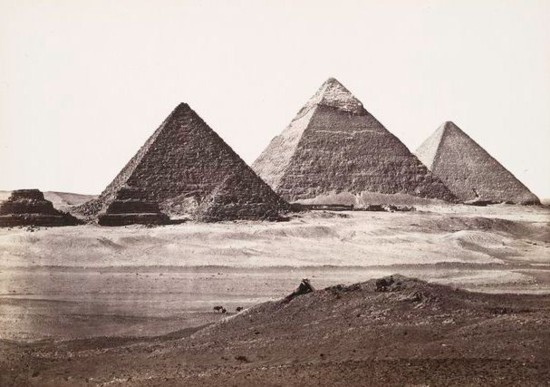 |
|
The Giza Pyramids were built by Pharaohs Cheops (Khufu
or Kheops), Chephren and Menkaure on the west bank of the Egyptian
Nile near the ancient capital of Memphis. The largest was built by
Cheops. Photographed by Francis Frith, 1862. |
|
|
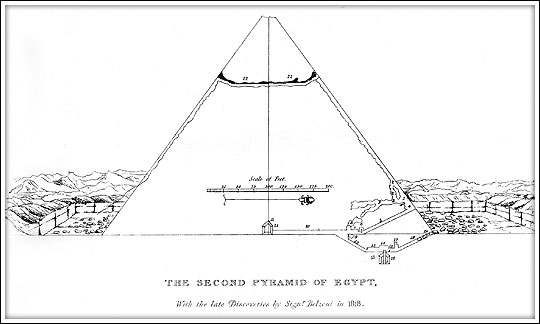 |
|
The Second Pyramid was built by Pharaoh Chephren (Khafra,
Khafre or Cephrenes), the son of Cheops. Chephren, it seems, did
not want to exceed the work of his father and because of this
modesty his construction has gained the name "Second Pyramid". |
|
Perhaps the most arduous of Belzoni's enterprises was the opening of the
second pyramid of Ghiza, known by the name of Cephrenes, as the largest
pyramid is known by the name of Cheops. Herodotus, the ancient Greek
historian, was informed that this pyramid had no subterranean chambers,
and his information being found in latter ages to be generally correct,
may be supposed to have operated in preventing that curiosity which
prompted the opening of the great pyramid of Cheops by Shaw. Belzoni,
however, perceived certain indications of sufficient weight to induce him
to make the attempt.
"The opening of this pyramid," says Mr. Salt, the English consul-general,
"had long been considered an object of so hopeless a nature that it is
difficult to conceive how any person could be found sanguine enough to
make the attempt; and even after the discovery, with great labour, of the
forced entrance, it required great perseverance in Belzoni, and confidence
in his own views, to induce him to continue the operation, when it became
evident that the extensive labours of his predecessors in the enterprise
had completely failed. The direct manner in which he dug down upon the
door affords the most incontestable proof that chance had nothing to do
with the discovery itself, of which Belzoni has given a very clear
description."
"On my return to Cairo," says he,
"I again went to visit the celebrated
pyramids of Ghiza; and on viewing that of Cephrenes I could not help
reflecting how many travellers of different nations, who had visited this
spot, contented themselves with looking at the outside of the pyramid, and
went away without inquiring whether any and what chambers exist within it;
satisfied, perhaps, with the report of the Egyptian priests, that 'the
pyramid of Cheops only contained chambers in its interior.' I then began
to consider the possibility of opening this pyramid. The attempt was,
perhaps, presumptuous; and the risk of undertaking such an immense work
without success deterred me in some degree from the enterprise. I am not
certain whether love for antiquity, an ardent curiosity, or ambition,
spurred me on most in spite of every obstacle, but I determined at length
to commence the operation.
"I set out from Cairo on the 6th of February, 1818, under pretence of
going in quest of some antiquities at a village not far off, in order that
I might not be disturbed in my work by the people of Cairo. I then
repaired to the Kaiya Bey, and asked permission to work at the pyramid of
Ghiza, in search of antiquities. He made no objection, but said that he
wished to know if there was any ground about the pyramid fit for tillage. I informed him that it was all stones, and at a considerable distance from
any tilled ground. He nevertheless persisted in inquiring of the cachef of
the province, if there was any good ground near the pyramids; and after
receiving the necessary information, granted my request.
"Having thus acquired permission, I began my labours on the 10th of
February, at a point on the north side, in a vertical section at right
angles to that side of the base. I saw many reasons against my beginning
there, but certain indications told me that there was an entrance at that
spot. I employed sixty labouring men, and began to cut through the mass of
stones and cement which had fallen from the upper part of the pyramid; but
it was so hard joined together that the men spoiled several of their
hatchets in the operation. The stones which had fallen down along with the
cement had formed themselves into one solid and almost impenetrable mass.
I succeeded, however, in making an opening of fifteen feet wide, and
continued working downwards in uncovering the face of the pyramid. This
work took up several days, without the least prospect of meeting with
anything interesting. Meantime I began to fear that some of the Europeans
residing at Cairo might pay a visit to the pyramids, which they do very
often, and thus discover my retreat and interrupt my proceedings.
"On the 17th of the same month we had made a considerable advance
downwards, when an Arab workman called out, making a great noise, and
saying that he had found the entrance. He had discovered a hole in the
pyramid into which he could just thrust his arm and djerid of six feet
long. Towards the evening we discovered a larger aperture, about three
feet square, which had been closed in irregularly by a hewn stone. This
stone I caused to be removed, and then came to an opening larger than the
preceding, but filled up with loose stones and sand. This satisfied me
that it was not the real but a forced passage, which I found to lead
inwards and towards the south. The next day we succeeded in entering
fifteen feet from the outside, when we reached a place where the sand and
stones began to fall from above. I caused the rubbish to be taken out, but
it still continued to fall in great quantities. At last, after some days'
labour, I discovered an upper forced entrance, communicating with the
outside from above, and which had evidently been cut by some one who was
in search of the true passage. Having cleared this passage I perceived
another opening below, which apparently ran towards the centre of the
pyramid.
"In a few hours I was able to enter this passage, which runs horizontally
towards the centre of the pyramid, nearly all choked up with stones and
sand. These obstructions I caused to be taken out, and at half-way from
the entrance I found a descent, which also had been forced, and which
ended at the distance of forty feet. I afterwards continued the work in
the horizontal passage above, in hopes that it might lead to the centre;
but I was disappointed, and at last was convinced that it ended there, and
that to attempt to advance that way would only incur the risk of
sacrificing some of my workmen, as it was really astonishing to see how
the stones hung suspended over their heads, resting perhaps by a single
point; indeed, one of these stones fell, and had nearly killed one of the
men. I therefore retired from the forced passage with great regret and
disappointment.
"Notwithstanding the discouragements I met with I recommenced my
researches on the following day, depending upon my indications. I directed
the ground to be cleared away to the eastward of the false entrance; the
stones, encrusted and bound together with cement, were equally hard as the
former, and we had as many large stones to remove as before. By this time
my retreat had been discovered, which occasioned me many interruptions
from
visitors,
"On February 28, we discovered a black of granite in an inclined direction
towards the centre of the pyramid, and I perceived that the inclination
was the same as that of the passage of the first pyramid, or that of
Cheops; consequently I began to hope that I was near the true entrance. On
the 1st of March we observed three large blocks of stone one upon the
other, all inclined towards the centre; these large stones we had to
remove as well as others much larger, as we advanced, which considerably
retarded our approach to the desired spot. I perceived, however, that I
was near the true entrance, and, in fact, the next day about noon on the
2nd of March, was the epoch at which the grand pyramid of Cephrenes was at
last opened, after being closed up so many centuries that it remained an
uncertainty whether any interior chambers did or did not exist."
Belzoni then gives a detailed description of the passages leading to the
great chamber of the pyramid. "On entering the great chamber," he
continues,
"I found it to be forty-six feet three inches long, sixteen
feet three inches wide, and twenty-three feet six inches high, for the
most part cut out of the solid rock (for this chamber was at the bottom of
the pyramid) except that part of the roof towards the western end. In the
midst we observed a sarcophagus of granite partly buried in the ground to
the level of the floor, eight feet long, three feet six inches wide, and
two feet three inches deep inside, surrounded by large blocks of granite,
being placed apparently to guard it from being taken away, which could not
be effected without great labour. The lid of it had been opened; I found
in it only a few bones of a human skeleton, which merit preservation as
curious relics, they being in all probability those of Cephrenes, the
reported builder of the pyramid."
It is necessary, however, to inform the young reader that Belzoni, being
unversed in osteology, was mistaken here, and that these bones, when
examined by scientific men in London, were found to be those of a cow;
thus giving foundation for the theory that the bodies of sacred animals,
the representatives of the Egyptian gods, were interred with extraordinary
honours.
|
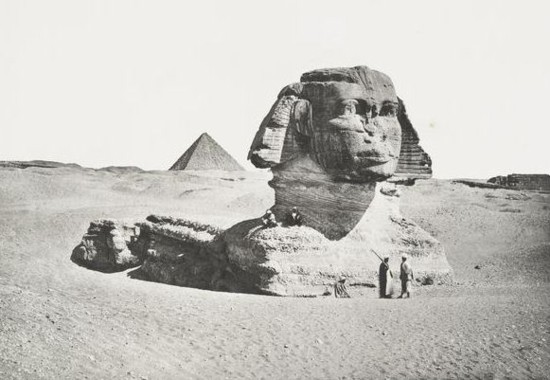 |
|
The Sphinx sits near the edge of the Giza plateau. It
is believed to date to the reign of Pharaoh Chephren (Khafre)
(Fourth Dynasty, 2558-2532), builder of the Second Pyramid of Giza,
which stands behind it. Photograph by Henri
Bechard, 1887. |
To narrate all the enterprises of Belzoni would occupy volumes. Let us
allude but to one more. He uncovered the front of the great Sphynx—that
gigantic monument which has been synonymous with "Mystery" from the
remotest ages of history. Numerous pieces of antiquity were as
unexpectedly as extraordinarily developed by this enterprise—pieces
which, for many centuries, had not been exposed to human eyes. Among other
things, a beautiful temple, cut out of one piece of granite, yet of
considerable dimensions, was discovered between the legs of the sphynx,
having within it a sculptured lion and a small sphynx. In one of the paws
of the great sphynx was another temple with a sculptured lion standing on
an altar. In front of the great sphynx were the remains of buildings,
apparently temples, and several granite slabs with inscriptions cut into
them, some entire and others broken. One of these is by Claudius Cæsar,
recording his visits to the pyramids. |